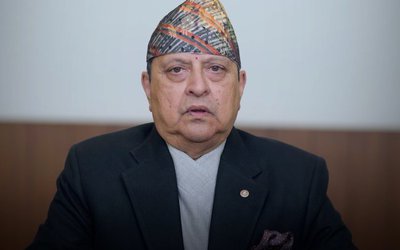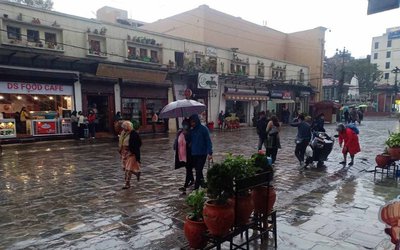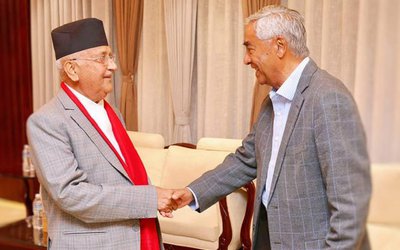
“It Took 20 Years To Build Back Kobe After Quake”
Yoshiaki Hisamatsu, executive director for Disaster Prevention Planning Department, Housing and Architecture Bureau, City of Yokohama, is in Kathmandu to train the civil servants of Kathmandu Metropolitan City and other 14 municipalities of Nepal. Yoshiaki Hisamatsu spoke to New Spotlight. Excerpts:
How do you see the state of buildings in Kathmandu?
We had seen and heard about the destruction of houses, heritage sites and temples. We had also seen foreign rescue teams working in Nepal. Soon after our arrival in Kathmandu, we visited the sites of destruction. That was our first direct encounter. We say in Japan that it is better to see with our own eyes once than to listen a hundred times. We saw the destruction of temples and palaces in Basantapur Durbar square.
What is your observation after the visit?
I was really hurt by the devastation. As all buildings, temples and heritages were destroyed in a similar manner, there might have been similar causes for destruction. Once we understand how the buildings were destroyed, it will help us to know how to build and how to make the buildings resilient. I hope that your engineers will leave no chance to make buildings earthquake resilient in the future. Like Yokohama City, Kathmandu Metropolitan is also a member of disaster and climate change cluster of City net. There is the need to have relations of cities in the cluster.
How long will reconstruction take?
It will depend on what capacity you have. We have also faced a major earthquake, magnitude of over 9 on Richter scale, and Tsunami in 2011. It took us almost five years to complete the reconstruction. The engineers designed the city raising the height of the ground level so that Tsunami and earthquake of similar scales will not do much harm in the future. The Kobe earthquake of 1995 also taught us a major lesson. It took us almost two decades to completely bring back the city as it was in the past.
How can you make buildings earthquake resilient?
After several earthquakes, we learned the process of building earthquake resilient buildings. As you need to put a lot of different ingredients to make tasty food, you need to put a lot of different materials to make a strong and earthquake resilient house. It is like cooking. You need to have a long preparation for building earthquake resilience. There is also the need to have a high level of awareness. Because of early warning system, Japan is able to reduce the casualty. Japanese people are very alert on Tsunami and earthquake. We have built our coastline city looking at the high level of tsunami fears. Sometimes, it goes beyond the level. Japan’s early warning system is very strong. We are planning to work in Nepal under JICA. This is my first visit.
How safe is it to stay inside the house?
One thing I want to make you clear is that we are not scientists and seismologists but we are public servants of City of Yokoyama. As public servants, we have closely worked with the people. We believe the enhancement of capacity of local community will help us in future disasters. This will also benefit the people. This is what we want to teach the public servants of municipalities. Our team has made efforts to strengthen the capacity of people. Our training is not from one engineer to another but one civil servant to another.
In the last earthquake, it was reported that many people died by following the suggestions of various organizations to hide beneath the table, bed and window during the time of earthquake. As a citizen of a country with frequent earthquakes, what do citizens need to be safer?
It depends upon the structures of buildings and materials used in the building. In Japan, we use light materials like wood and wood products in building construction. However, I saw heavy materials like concrete, brick, stone with mud used by Nepalese in building construction. People are naturally unsafe in case a building constructed using heavy materials collapses. Table and bed cannot uphold the weight of big concrete. However, the houses in Japan use light materials and the table and bed can uphold the weight and save life. Nepal and Japan have different situations.
As Nepal is surrounded by mountains and Japan is surrounded by sea, don’t you think there will be more damage in the mountain areas?
Of course, Japan is surrounded by sea but we too have mountains in the middle of the land. Japan faces two different kinds of destruction in the big earthquakes. In the coastal areas, there will be possibility of tsunami and hill areas like landslides and flood. Like your country, earthquake has adverse effects in the hill settlement. Of course, tsunami can also do a big damage.
How effective is the early warning system?
Newly developed technology is effective if the depth of the earthquake epicenter is deeper. If the epicenter is close to surface, the land shakes quickly and the early warning equipment is less effective. As the disaster preparedness and level of awareness in Japan is very effective, the casualty and damage is lowest compared to other countries. Disaster preparedness and early warning system backed by awareness can reduce the damage.
What is the purpose of your visit to Nepal?
Upon the request of Kathmandu Metropolitan City, we visited Nepal. Kathmandu Metropolitan and City of Yokohama are both the members of CITYNET and both the cities fall under the disaster cluster. We conducted week long training for the municipal officials. We don’t have projects in Nepal. We are considering working with private sector from next year. Organized by Kathmandu Metropolitan City, officials of 14 municipalities are participants of the training. We are four experts.

Keshab Poudel
Poudel is the editor of New Spotlight Magazine.
- KUL MAN GHISING: Bowing Down To The People
- Apr 13, 2025
- POLITICAL VIOLENCE: Culture of Impunity
- Apr 11, 2025
- PM OLI MEETS PM MODI: No Progress
- Apr 09, 2025
- PM OLI’S THAILAND VISIT: Flip Flop
- Apr 08, 2025
- FM Dr. Deuba’s India Visit: Mission Aborted
- Mar 26, 2025















